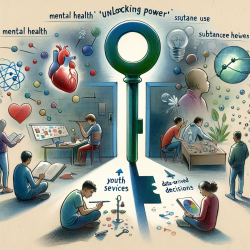Introduction
As practitioners dedicated to improving the lives of young individuals, understanding the complex needs of youth who use substances is critical. A recent cohort study titled "Patterns of service utilization among youth with substance use service need" offers valuable insights into how integrated youth services (IYS) can be leveraged to better meet these needs. This blog will explore the key findings from the study and provide actionable steps for practitioners to enhance their service delivery.
Understanding Service Utilization Patterns
The study examined data from 6,181 youths aged 12 to 24 years who accessed IYS centers in Canada. It identified three levels of substance use service needs: low, moderate, and high. Notably, 48% of the youths had low needs, 30.6% moderate, and 21.4% high. The research highlighted that mental health and substance use (MHSU) services were the most utilized across all groups, followed by counseling services.
Key Findings and Implications
- Youths with high substance use needs had a 10% higher rate of service visits and utilized 10% more services compared to those with low needs.
- The rate of service visits increased by 30 to 50% for youths who rated their health as good/fair/poor.
- Youths with poor self-rated mental health had a 40 to 60% increase in service visits.
These findings underscore the importance of providing comprehensive, multidisciplinary care that adapts to the evolving needs of youths. Practitioners should consider the following strategies to improve outcomes:
Actionable Strategies for Practitioners
- Personalize Care Plans: Tailor interventions to match the individual’s clinical and social profile. This approach can help in providing targeted support and improving engagement.
- Enhance Follow-Up: Implement robust follow-up mechanisms to ensure continuity of care, especially for youths with high service needs.
- Incorporate Self-Rated Health Measures: Utilize simple one-item measures for self-rated health and mental health in routine assessments to identify youths who may require additional support.
- Foster a Youth-Friendly Environment: Create a welcoming and non-judgmental space that encourages youths to seek help and engage with services.
Encouraging Further Research
The study provides a foundation for further exploration into the effectiveness of IYS models. Practitioners are encouraged to conduct additional research to understand the long-term impacts of integrated services on youth outcomes. Collaboration with research institutions can also facilitate the development of evidence-based practices tailored to the unique needs of youth populations.
Conclusion
Integrated youth services hold significant potential for addressing the complex needs of youths who use substances. By leveraging data-driven insights and implementing targeted strategies, practitioners can enhance service delivery and improve outcomes for young individuals. To delve deeper into the research findings, please follow this link: Patterns of service utilization among youth with substance use service need: a cohort study.










